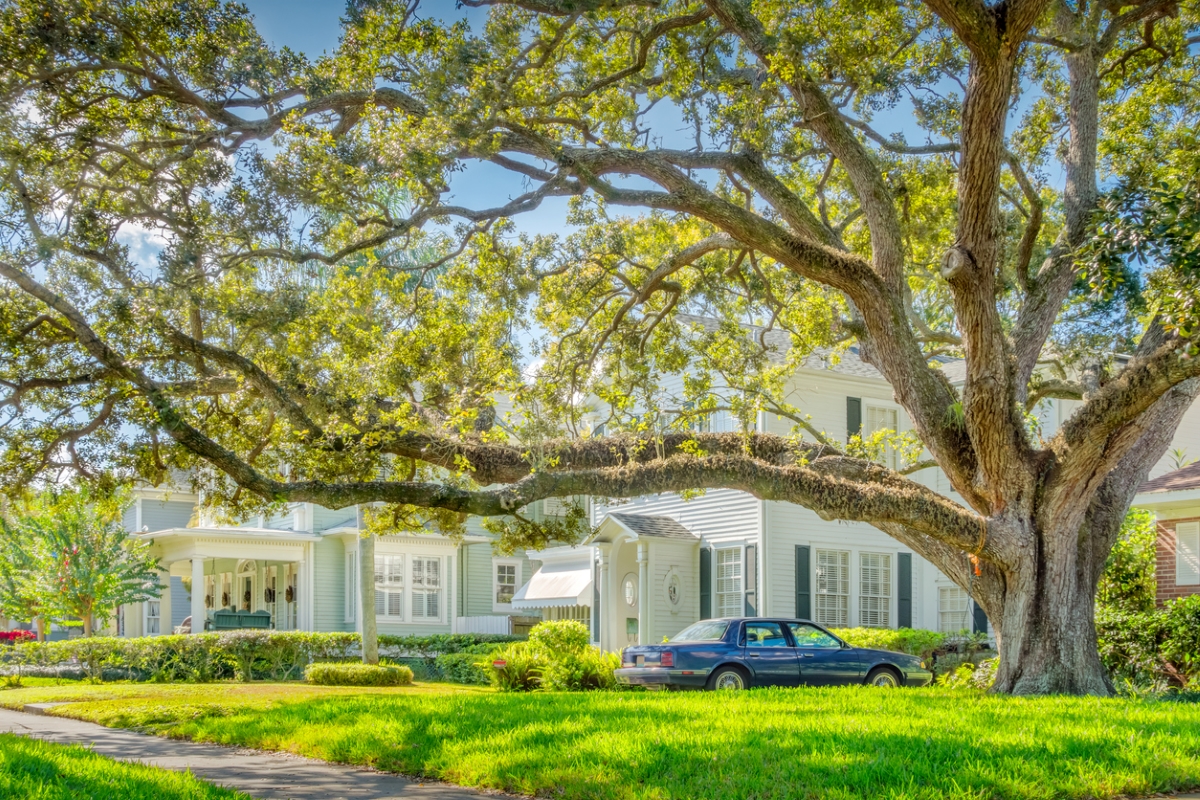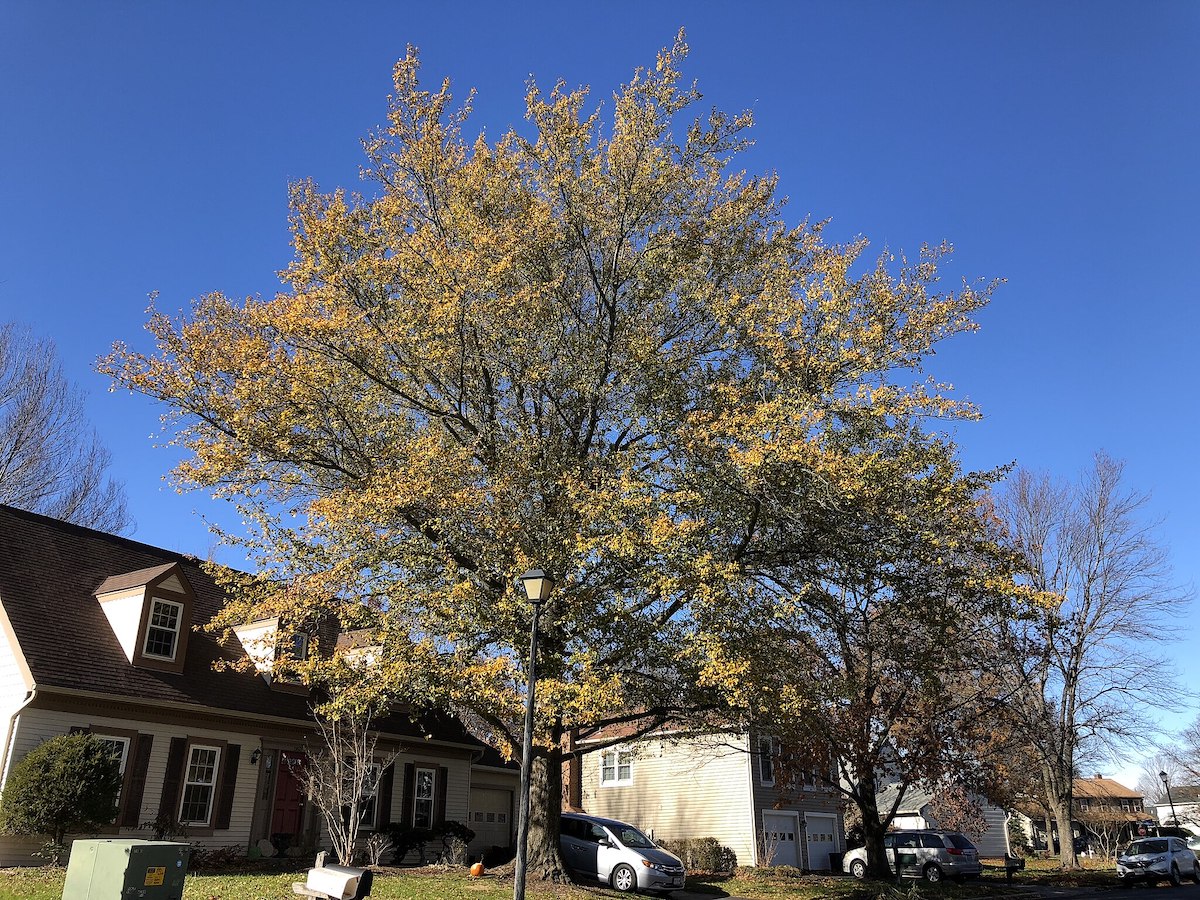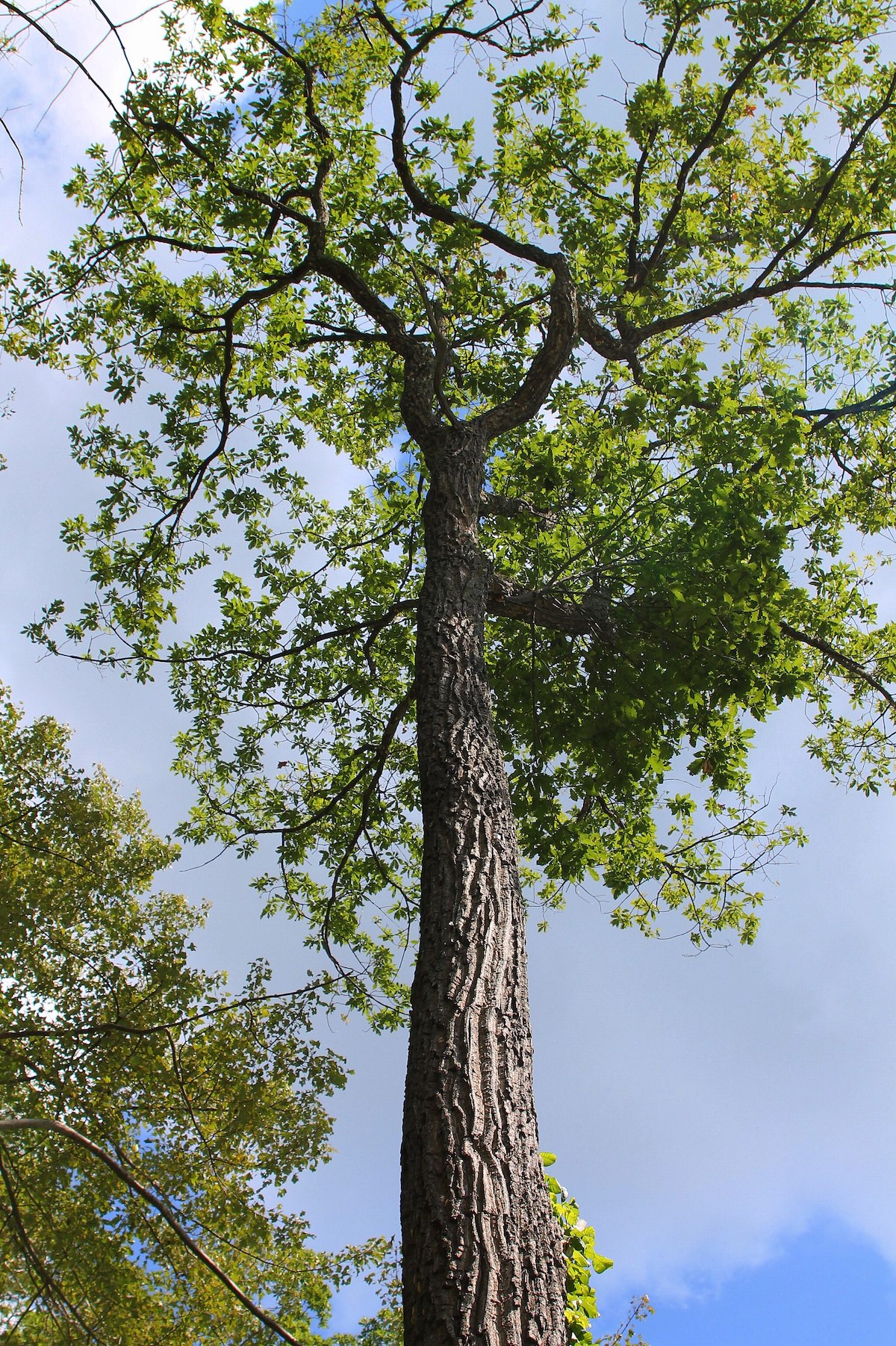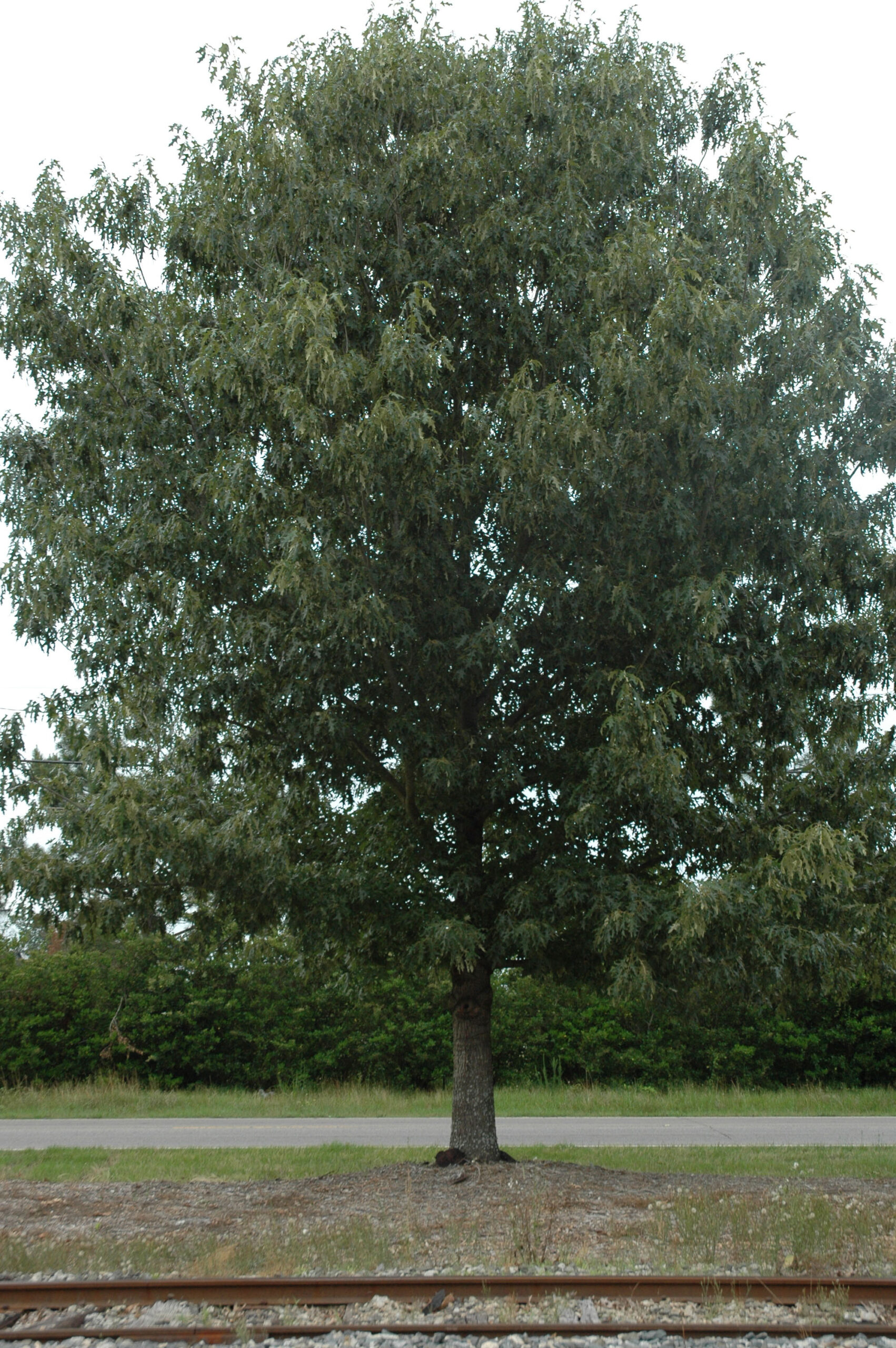

We may earn revenue from the products available on this page and participate in affiliate programs. Learn More ›
Oak trees have been around for more than 50 million years, with individual trees easily living 1,000 years. One of the oldest oak trees in the U.S. is believed to be at least 2,624 years old. The longevity of this hardwood has imbued the oak with special meanings, such as wisdom, honor, and strength of character. Reaching 148 feet high, oaks are a symbol of power, courage, and resilience, and they are often considered to be spiritual.
There are more than 500 types of oak trees, all of which began life as a tiny acorn. The species are divided into two general categories: white oak vs. red oak.
Red Oaks vs. White Oaks
The two primary categories of oak trees are red and white. The major differences are white oak (the most common) is taller with a wider spread, but it is a slow grower when compared with red oak, which grows more than 2 feet per year. White oaks turn golden in autumn, while red oaks display bright red foliage. White oak tree bark is coarse with deep ridges, versus smoother red oak bark. White oak leaves have rounded tips as opposed to the pointier red oak leaves.
White oak wood is denser and more resistant to rot, so it’s used for outdoor patio furniture and boats. It has larger, more pronounced ray flecks when quartersawn and has been used in antiques more than red oak, although the red variety is often used for interior cabinets, flooring, and indoor furniture—possibly because it’s lighter and more porous, with an open grain. White oak tends to be more expensive than red. In terms of care, white oaks can handle some drought and resist many diseases, while red oaks are more particular about needing regular waterings.
RELATED: 12 Things an Arborist Wishes You Knew
1. Black oak (Quercus velutina)

The black oak tree, named for its dark-black/brownish-gray bark, features glossy green oak leaves that have bristles at the tips of the lobes. Autumn foliage is red and orange. Hardy to Zone 3, this member of the red oak group lives in the central and eastern parts of the country—except for Florida. Preferring rich, well-draining soil, it also can tolerate poor, dry soil.
Often found on slopes and hills, black oak has a prominent taproot that ensures survival through poor conditions. But it cannot abide shade; black oak requires full sun, typically growing 50 to 80 feet tall, though some can reach 100 feet high. Black oak is hard to find in nurseries because it’s difficult to transplant.
Best For: Black oak does best in well-draining, acidic soil and full sun in Zone 3 (up to Zone 9).
2. Bur oak (Quercus macrocarpa)

This white oak group member, sometimes called majestic oak, is a long-lived (200 to 300 years) native that can grow up to 90 feet tall and wide, producing abundant shade. Like many oak tree leaves, the leaves of the bur oak are long, elliptical, and green, with five to seven rounded lobes. While the bur oak’s autumn color is not spectacular, its bark is, with deep ridges of gray that become more distinct with age, and corky twigs.
This slow-growing oak with a long taproot tolerates a variety of soil types (sandy, loamy, clay, and silt), but it must have full sun and does not like salt spray. Therefore, placement away from roads is best. This tough oak withstands pollution, wind, drought, and compacted soil, but it doesn’t like wet soil. Bur oak produces acorns that are larger than most and have fringed caps.
Best For: Bur oak can grow in most soil types in Zones 3 through 8 as long as it has full sun and is away from salt spray.
3. Laurel oak (Quercus laurifolia)

In the red oak group, laurel oak defies typical oak leaf identification because its leaves are small, narrow blades that look more like those of the English laurel than the typical white oak leaf. They turn a yellowish-brown color in autumn and can hang on through the winter. Planted throughout the South from Virginia to Florida and west to Texas as an ornamental tree, laurel oak is large—reaching up to 100 feet tall—but is a short-lived oak.
Laurel oak can grow in most soil types, and the tree tolerates wet soil. It often is found along riverbanks, floodplains, and the edges of swamps. It does well in full sun or part shade. Because it’s a fast grower, laurel oak sometimes has weak wood that is susceptible to storm damage.
Best For: Grown in Zones 7 through 9, laurel oak is known as swamp laurel oak for its prolific growth near wetland areas.
4. Live oak (Quercus virginiana)

Live oaks are evergreen in Zones 7 through 10. Familiar as the stately oaks from which Spanish moss dangles, live oaks are a staple in the South. Adaptable to most soil types, this oak prefers well-draining, slightly acidic soil, whether dry or moist. Smaller than white oaks, they still can reach up to 80 feet tall.
A shallow root system makes live oaks vulnerable to high-wind conditions, just as their thick bark, which protects them from insects and disease, makes them flammable and thus, susceptible to fire. Young live oaks require pruning to establish a dominant leader and lift the canopy. Skinny leaves and brownish-black, oblong acorns distinguish this oak.
Best For: Because they can tolerate salt spray and compacted soil, live oaks work well as street trees in Zones 7 through 10.
5. Pin oak (Quercus palustris)

One of the fastest-growing shade trees, the pin oak can reach 70 feet tall in Zones 4 through 8. Because they tolerate wet soil, these oaks often are seen near rivers, lakes, and other bodies of water. While they require full sun, they create dense shade underneath their canopies. They tend to prefer soil that is acidic, loamy, sandy, or rich, and that drains well. These oaks can handle both heat and air pollution.
Leaves remain on young trees throughout winter, adding color through a barren season. Easier to transplant than most oaks, the pin oak is often used as a specimen or shade tree in the landscape. It features deeply lobed green leaves and rounded, dark-brown acorns. In autumn, leaves turn to red and then coppery brown. Its acorns feed squirrels, deer, songbirds, and other animals, and they are an important food for ducks.
Best For: Fast-growing pin oaks are excellent shade or specimen trees with a pleasing pyramidal shape.
6. Water oak (Quercus nigra)

Water oak, a member of the red oak group, is a fast-growing tree frequently used as an ornamental or for shade. Grown in Zones 6 through 9, it retains its only slightly lobed leaves through winter, after they turn from summer bluish green to a stunning autumnal yellow.
Preferring full sun to partial shade, water oak can tolerate a wide range of soil types, including heavy, compacted soil, though it will do best when soil drains well. Attractive and easy to care for, it is more of a short-lived oak because its wood is fragile and prone to insects and disease. However, it transplants easily and grows in a pleasing rounded shape, making it a popular choice for the landscape.
Best For: A popular specimen tree in Zones 6 through 9, water oak is a fast-growing tree that provides abundant shade and dazzling color for a shorter lifetime than many oaks.
7. Chestnut oak (Quercus prinus)

Typically seen in the Appalachian region, where soil is infertile and rocky, the chestnut oak can survive on steep slopes where other types of oak trees can’t. This slow-growing tree is part of the white oak group. It reaches up to 70 feet tall and features chestnut-like leaves, from whence it gets its name. With hardly any indentations, leaves are pink as they first unfurl and turn silvery before finally becoming dark green. They then turn orange yellow to yellow brown in autumn.
The tree’s bark is an attractive silvery-white color. Not much of an acorn tree, the chestnut tree produces few acorns, yet it’s still popular with wildlife. Preferring full sun and dry, well-draining soil, the chestnut oak grows in Zones 4 through 8.
Best For: Grows well in poor, rocky soils where other trees don’t, but the medium-size, slow-growing chestnut oak can survive anywhere in Zones 4 through 8.
RELATED: 7 Types of Pine Trees That are Great for Home Landscapes
8. Cherrybark oak (Quercus pagoda)

A red oak highly valued for furniture making, the cherrybark oak gets its name from its bark, which resembles a black cherry tree’s dark-gray, scaly bark with deep ridges. A fast grower, it can easily reach 130 feet tall and has a straight trunk. Its shiny, dark-green leaves are slightly lobed and shaped like a pagoda. It takes acorns 2 years to mature on trees that are at least 25 years old.
Often found from Maryland to Texas and from Illinois to the Florida Panhandle, this deciduous native grows in Zones 6 through 9 in well-draining, acidic, loamy, or sandy soil and full sun or partial shade. Attractive to pollinators and small mammals, cherrybark oak is resistant to deer and fire.
Best For: This tall, pagoda-shaped oak needs room to grow in Zones 6 through 9 and prefers moist, well-draining bottomland spots, but adapts to drier sites.
9. Willow oak (Quercus phellos)

Willow oaks feature thin, spear-shaped leaves that look like those of a willow, which is where this medium-size oak got its name. Those leaves turn from summer’s green to yellow, orange bronze, and russet in autumn. This medium-size tree grows into a pyramidal shape at a moderate rate, eventually reaching up to more than 60 feet tall.
Grown in Zones 5 through 9, willow oak prefers full sun and acidic, well-draining soil, but it tolerates most soils, as well as wind, salt spray, and moderate drought. This, along with the fact that it transplants well, qualifies it for planting along streets, in parking lot islands, and in front lawns. Its dark acorns have faint stripes.
Best For: A medium-size tree, willow oak can be planted in yards and along streets because it tolerates salt spray, poor soil, and moderate drought.
10. Scarlet oak (Quercus coccinea)

One look at the scarlet oak’s brilliant spring and fall color will tell you all you need to know about its name. It’s that extraordinary color that makes it a favorite to plant in yards and along streets. The tree’s delicate branching pattern, almost-black bark, and leaves that linger over winter add to its attraction. A fast-growing tree that reaches up to nearly 80 feet tall, scarlet oak is drought-tolerant and grows best in sandy soil, but it tolerates a variety of soil types as long as they aren’t alkaline.
Despite a dominant taproot, scarlet oak has spreading lateral roots that make it easier to transplant than some oaks. Given full sun in Zones 4 through 9, it rewards tree lovers and wildlife.
Best For: A good choice for lawns and along streets, the scarlet oak is a fast-growing, medium-size tree that produces stunning color.
